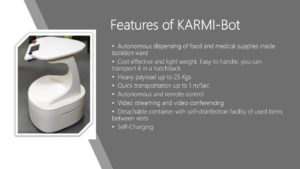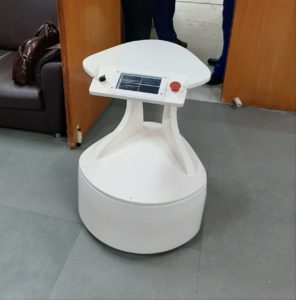If all goes to plan, from Friday, 3 April, a robot will go into an isolation facility housing patients of Covid-19 to administer food and medication– a step towards providing care without putting medical staff at risk. This revolutionary move in medical care during this pandemic comes — not surprisingly — from Kerala
Asimov Robotics, a company under the Kerala start-up mission, will introduce this robot named KARMIbot to a fresh isolation zone in Kochi medical college. Founder and CEO of the company T Jayakrishnan tells us that while they can make one robot per day – which would mean more hospitals and even other states receiving this capability – the nation-wide lockdown has affected their ability to receive spare parts which are, he says, stuck in Haryana and Mumbai.
Jayakrishnan hopes to receive help from the Department of Science & Technology (DST) which noticed his company after Congress MP Shashi Tharoor shared a video on Twitter of Asimov Robotics’ coronavirus awareness robot, which passed around masks and hand sanitisers to the public. “We have shared all the details with DST and so I’m hoping we will get their support very soon. We are getting enquiries from various states and the way it would be successful is if this transportation issue will be sorted out,” Jayakrishnan tells us over the phone from Kochi.
With the number of infected growing in India and in his home state, Kerala, Jayakrishnan says they decided to make a robot which is cheap, easy to transport to various places, easy to use and with a high payload and a critically important feature: capable of disinfecting itself after coming out of the isolation zone. While filing this report, India had a total of 2,567 Covid-19 positive cases out of which 72 have succumbed to the disease. Kerala has 286 confirmed cases, with 26 people having recovered, while two have died.

While the state is working to contain the spread of the virus, new cases are still emerging. KARMIbot, which will be deployed in the wards with patients who have tested positive but are asymptomatic, will take the pressure off the already overloaded medical staff. Coming with two levels of platform and payload capacity of 25 kg, it will carry food and medical supplies into the ward. “Once patients show symptoms, they’ll need higher levels of care. But KARMIbot is customised to address those patients who have been diagnosed with type A of the disease that is asymptomatic but positive. This makes it safer for the healthcare professionals”, Jayakrishnan adds.
The robot has two cameras. One is for video conferencing which can be used by the healthcare staff to interact with the patient, and even by a family member sitting outside the ward. The other is for the robot to communicate with the patient itself, enabling some sort of interaction, he adds.
What makes it even better is that when it exits the isolation ward, it disinfects itself. Jayakrishnan believes there is in fact a lot more that can be done by people in the country, tapping into the different aspects of medical requirements presently. “People all over India have really good capabilities and this is the time to unite and do something collectively for the good of mankind”.
We asked him what he thinks about how the future looks like, post the pandemic. Will society try and become more contact-less? Less dependent on humans? He thinks they must.
“Robotics has a high potential and can make many of the processes contactless like for example in retail shops or security. Robotics is not a standalone technology, there are many supplementary technologies that can help. The possibilities are immense”, he says ending the conversation with a question: “Why should we have human beings for each and every small task?”.
In the present crisis, this has become a more pertinent question than ever.

A new world
With the pandemic, we have understood how our lives can completely shut down when they rely so heavily on having human interaction. Some of the things we enjoy the most, like eating out, getting food delivered, going to a bar, are all entirely based on human contact. And while going to a bar cannot, for obvious reasons become contactless, things like contactless home delivery could become a reality very soon.
Amazon, for one, is trying to launch its drone delivery service, Prime Air. If and when that becomes a reality in India would have to be seen.
Another venture of Amazon called Amazon Go which has four stores just in the US, requires no waiting in line. The store works with an Amazon Go application — you enter the Amazon Go store, take the products you want and leave. Amazon says the technology works by using the same type of technology found in self-driving cars, such as computer vision, sensor fusion and deep learning. This technology can detect when products are taken or returned to the shelves and keeps track of them in your virtual cart.
When you leave the store with your goods, your Amazon account is charged and you are sent a receipt. This means no needless queuing up, which means less chances of human contact.
There was another technology which had grabbed a lot of interest back in 2016. While we were unable to access its website, we read about it on a platform for funding technologies. The Indian innovation by Aman Kajaria is called i2u2. The Coronavirus lockdown – an essential way of keeping people from human interaction which opens them to the risk of being infected – and of course the virus itself has created immense fear of basic interaction face to face, so this innovation may just be the answer.
An article had quoted Kajaria explaining the tech which would be accessible pretty easily. All one had to do was buy the robot, unpack it, charge it, connect it to a phone or tablet, download the i2u2 app, and set it up. We couldn’t find the app but we must have piqued your curiosity, so let’s go on to what the tech is all about.

It’s a robot they say, for personal and family use. While creepy it may be to some, it allows a family member to log in remotely via a smartphone app and be “present” at home via the robot. “This telepresence gives freedom of movement through the house and freedom to communicate via video with anyone or anything in the house e.g. children, pets, elderly parents, spouses.
The distinction from a pure video calling solution like Skype or Facetime, it says, is that the user ‘dialling in’ has full control of both video and mobility of the device (the robot) in the house. This may not work for all, say having your mom’s face and voice follow you around, it could be in fact something people need in the near future as one lives a more disconnected life from real humans.
The company even calls the robot “the alter-ego of the user dialling in”, enabling the person to have a more natural conversation as with “other family members”, something our lonely worlds may in fact need.
Artificial intelligence will be our future as we become more aware of how random human contact can be fatal. A warped world where we fear each other because one could stumble upon a knife wielding murderer and tech is the only way we can live freely.





